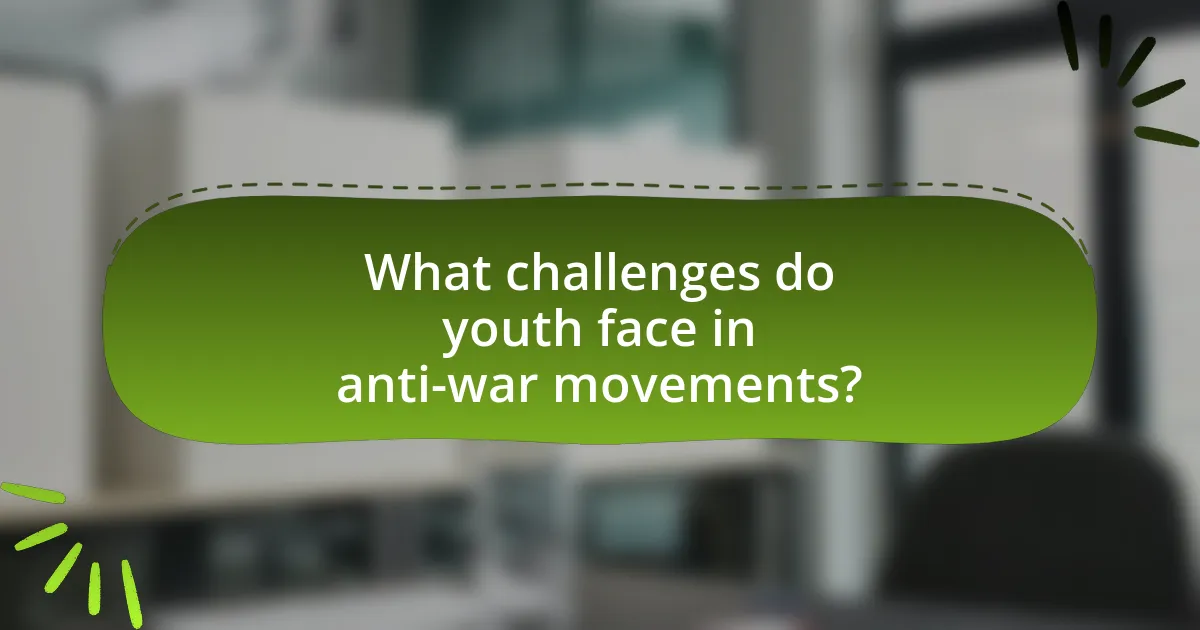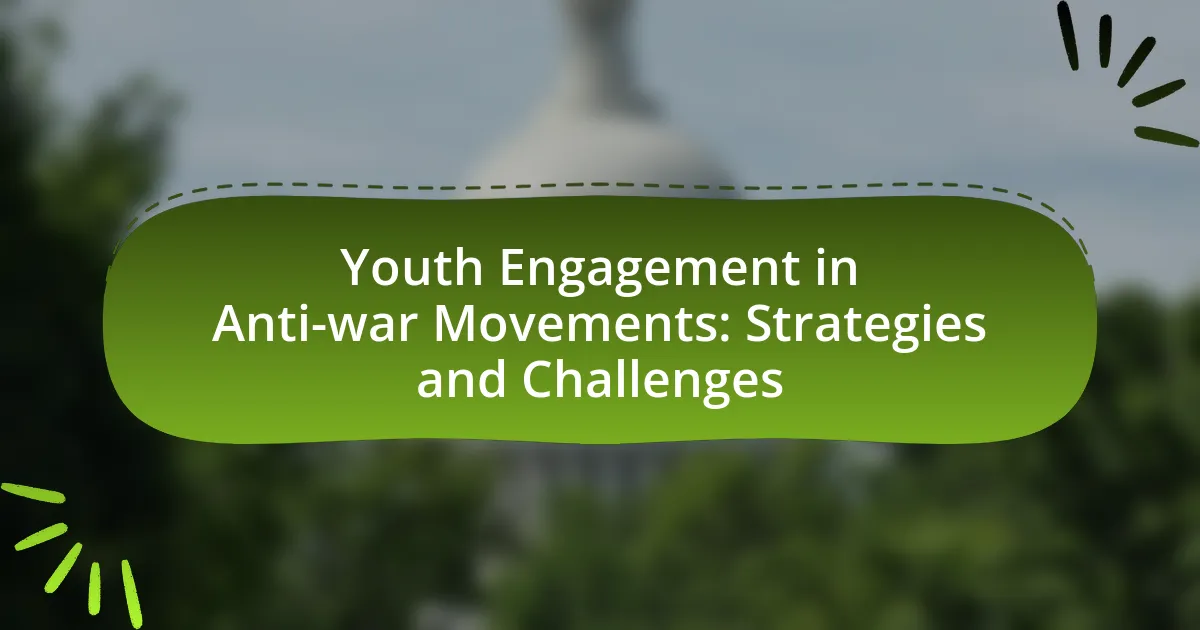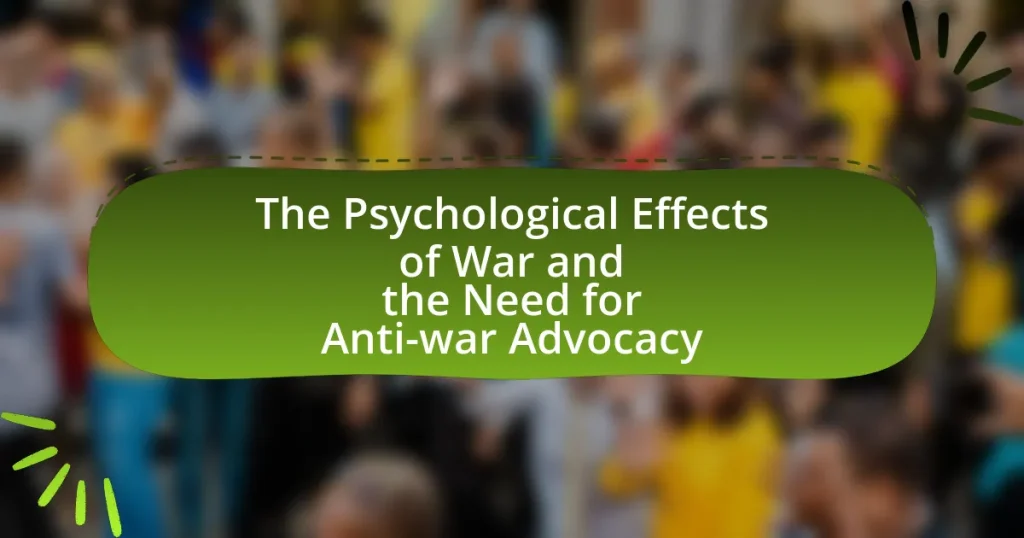Youth engagement in anti-war movements encompasses the active participation of young individuals in advocating against war and militarism through various means such as protests, social media campaigns, and grassroots organizing. This article explores the significance of youth involvement, highlighting historical examples like the Vietnam War protests, and examines how youth influence public perception of war. It discusses key characteristics of youth engagement, including activism, digital mobilization, and intersectionality, while also addressing the challenges faced by young activists, such as limited resources and societal perceptions. Additionally, the article outlines effective strategies for youth participation, the role of educational institutions, and the importance of collaboration with other organizations to enhance the impact of anti-war initiatives.

What is Youth Engagement in Anti-war Movements?
Youth engagement in anti-war movements refers to the active participation of young individuals in advocating against war and militarism. This engagement often manifests through protests, social media campaigns, educational initiatives, and grassroots organizing, aiming to influence public opinion and policy regarding military conflicts. Historical examples include the significant role of youth during the Vietnam War protests in the 1960s, where students mobilized to challenge U.S. involvement in Vietnam, demonstrating the power of youth activism in shaping political discourse and promoting peace.
Why is youth engagement important in anti-war movements?
Youth engagement is crucial in anti-war movements because it harnesses the energy, creativity, and innovative perspectives of younger generations to challenge militarism and advocate for peace. Historically, youth have played pivotal roles in significant anti-war movements, such as the Vietnam War protests in the 1960s, where young activists mobilized mass demonstrations and influenced public opinion. Engaging youth not only amplifies their voices but also ensures that the values and priorities of future generations are represented in peace advocacy. Furthermore, studies indicate that youth-led initiatives can effectively utilize social media and digital platforms to reach wider audiences, thereby increasing awareness and participation in anti-war efforts.
What historical examples illustrate youth involvement in anti-war efforts?
Historical examples of youth involvement in anti-war efforts include the Vietnam War protests in the 1960s and 1970s, where college students organized demonstrations, sit-ins, and teach-ins to oppose U.S. military involvement in Vietnam. Notably, the Students for a Democratic Society (SDS) played a significant role, mobilizing thousands of young people across the country. Additionally, the Kent State University shooting in 1970, where four students were killed during a protest, galvanized national outrage and further fueled youth activism against the war. These events illustrate the powerful impact of youth engagement in shaping public opinion and policy regarding military conflicts.
How does youth engagement influence public perception of war?
Youth engagement significantly influences public perception of war by shaping narratives and mobilizing collective action against military conflicts. When young people actively participate in anti-war movements, they often utilize social media platforms to disseminate information, challenge mainstream narratives, and raise awareness about the consequences of war. For instance, the global youth-led climate strikes have demonstrated how young activists can effectively draw parallels between militarization and environmental degradation, thereby reframing public discourse around war. Research indicates that youth involvement in such movements can lead to increased public skepticism towards military interventions, as seen in the rise of anti-war sentiment during the Iraq War, where youth activism played a crucial role in mobilizing protests and influencing public opinion.
What are the key characteristics of youth engagement in these movements?
Key characteristics of youth engagement in anti-war movements include activism, digital mobilization, and intersectionality. Activism is evident as young people often lead protests and organize grassroots campaigns, demonstrating a commitment to social change. Digital mobilization is significant, with youth utilizing social media platforms to spread awareness, coordinate actions, and connect with like-minded individuals globally. Intersectionality plays a crucial role, as youth engagement often encompasses various social justice issues, recognizing the interconnectedness of war with race, gender, and economic inequality. These characteristics are supported by studies showing that youth are more likely to participate in movements that align with their values and utilize technology for advocacy, as seen in the global climate strikes and Black Lives Matter protests.
How do social media and technology facilitate youth participation?
Social media and technology facilitate youth participation by providing accessible platforms for communication, organization, and mobilization. These tools enable young people to share information rapidly, connect with like-minded individuals, and coordinate actions, such as protests or awareness campaigns. For instance, the Arab Spring demonstrated how social media platforms like Twitter and Facebook were instrumental in organizing protests, allowing youth to bypass traditional media and engage directly with a global audience. Additionally, studies show that 70% of young people use social media to engage in political discussions, highlighting its role in fostering civic engagement and activism among youth.
What role do educational institutions play in fostering youth activism?
Educational institutions play a crucial role in fostering youth activism by providing a platform for critical thinking, civic engagement, and social awareness. Schools and universities often encourage students to participate in discussions, debates, and projects that address social issues, including anti-war movements. For instance, research conducted by the Center for Information and Research on Civic Learning and Engagement (CIRCLE) indicates that students involved in civic education programs are more likely to engage in activism and community service. Additionally, educational institutions often host events, workshops, and campaigns that empower students to voice their opinions and mobilize for change, thereby enhancing their capacity to participate in movements against war and other social injustices.

What strategies do youth employ in anti-war movements?
Youth employ various strategies in anti-war movements, including grassroots organizing, social media activism, and coalition building. Grassroots organizing involves mobilizing local communities to participate in protests and demonstrations, which has been effective in raising awareness and generating public support. Social media activism allows youth to disseminate information rapidly, engage with a broader audience, and coordinate actions, as seen in movements like the March for Our Lives. Coalition building with other organizations enhances their impact by pooling resources and amplifying voices, exemplified by collaborations between youth groups and established anti-war organizations. These strategies collectively contribute to the effectiveness of youth-led anti-war initiatives.
How do grassroots organizing and mobilization work?
Grassroots organizing and mobilization work by empowering individuals at the community level to collectively address social issues and advocate for change. This process typically involves building relationships, fostering local leadership, and creating networks that facilitate communication and action among community members. For instance, grassroots movements often utilize strategies such as door-to-door canvassing, community meetings, and social media campaigns to raise awareness and mobilize support for their causes. Historical examples include the Civil Rights Movement, where local activists organized protests and voter registration drives, demonstrating the effectiveness of grassroots efforts in achieving significant social change.
What are effective methods for recruiting young activists?
Effective methods for recruiting young activists include leveraging social media platforms, organizing community events, and providing educational resources. Social media, such as Instagram and TikTok, allows for targeted outreach and engagement with younger audiences, as 71% of teens use these platforms for information and connection. Community events, like workshops and rallies, create opportunities for direct interaction and foster a sense of belonging among potential activists. Additionally, offering educational resources, such as webinars and informative articles, equips young individuals with the knowledge needed to engage meaningfully in activism. These methods have been shown to increase participation rates and build a committed activist base.
How can youth leverage art and culture in their campaigns?
Youth can leverage art and culture in their campaigns by using creative expressions such as visual art, music, and performance to communicate messages and engage audiences. For instance, art can serve as a powerful tool to evoke emotions and raise awareness about anti-war issues, as seen in the Vietnam War protests where artists created impactful imagery and songs that resonated with the public. Additionally, cultural events like exhibitions and concerts can foster community involvement and solidarity, amplifying the campaign’s reach. Historical examples, such as the use of protest songs during the Civil Rights Movement, demonstrate how art can mobilize youth and inspire collective action against war and violence.
What role does collaboration with other organizations play?
Collaboration with other organizations plays a crucial role in enhancing the effectiveness and reach of youth engagement in anti-war movements. By pooling resources, knowledge, and networks, organizations can amplify their impact, mobilize larger groups, and create a unified front against war. For instance, partnerships between youth-led groups and established NGOs can provide access to funding, training, and advocacy platforms, which are essential for sustaining long-term campaigns. Research indicates that collaborative efforts can lead to a 30% increase in participation rates in social movements, demonstrating the tangible benefits of such alliances.
How can partnerships enhance the impact of youth-led initiatives?
Partnerships can enhance the impact of youth-led initiatives by providing access to resources, expertise, and networks that amplify their efforts. Collaborating with established organizations allows youth initiatives to leverage funding, mentorship, and training opportunities, which can significantly increase their reach and effectiveness. For instance, a study by the United Nations Development Programme highlights that youth organizations that partner with NGOs see a 40% increase in project success rates due to shared knowledge and resources. This collaborative approach not only strengthens the initiatives but also fosters a sense of community and shared purpose among diverse stakeholders, ultimately leading to more sustainable outcomes in anti-war movements.
What are the benefits of intergenerational collaboration in anti-war movements?
Intergenerational collaboration in anti-war movements enhances the effectiveness and reach of advocacy efforts. This collaboration allows for the sharing of diverse perspectives, where younger activists bring innovative ideas and energy, while older generations contribute experience and historical context. For instance, the combination of youth-led initiatives, such as the March for Our Lives, with the wisdom of seasoned activists from movements like the Vietnam War protests has proven to create a more robust and inclusive dialogue. Research indicates that movements that engage multiple generations can mobilize larger audiences and foster a sense of community, which is crucial for sustained activism.

What challenges do youth face in anti-war movements?
Youth face several challenges in anti-war movements, including lack of resources, limited political influence, and societal pushback. These challenges hinder their ability to mobilize effectively and advocate for change. For instance, many young activists often struggle with funding and access to platforms for their voices, which can limit their outreach and impact. Additionally, youth may encounter skepticism from older generations who may not take their perspectives seriously, leading to feelings of isolation. Furthermore, societal norms and media portrayals can stigmatize anti-war sentiments, making it difficult for young people to express their views openly. These factors collectively create significant barriers to youth participation in anti-war movements.
What are the common obstacles to youth participation?
Common obstacles to youth participation include lack of access to information, limited opportunities for engagement, and societal perceptions that undervalue youth voices. Research indicates that many young people feel excluded from decision-making processes due to insufficient platforms for expression and participation. For instance, a study by the United Nations found that 70% of youth believe their opinions are not considered in political discussions, highlighting the disconnect between youth and decision-makers. Additionally, socioeconomic barriers, such as financial constraints and lack of transportation, further hinder youth involvement in movements, making it difficult for them to engage actively.
How do societal perceptions of youth affect their activism?
Societal perceptions of youth significantly influence their activism by shaping the legitimacy and visibility of their efforts. When society views young people as passionate and capable, it encourages their participation and amplifies their voices in movements, such as anti-war protests. Conversely, negative perceptions, such as viewing youth as inexperienced or irresponsible, can undermine their credibility and diminish the impact of their activism. Research indicates that youth-led movements, like the March for Our Lives, gained traction partly due to positive media portrayals that highlighted their commitment and organization, demonstrating how societal views can enhance or hinder youth activism.
What legal and political barriers hinder youth engagement?
Legal and political barriers that hinder youth engagement include restrictive voting laws, age-related limitations on participation in political processes, and lack of representation in decision-making bodies. For instance, many countries impose age restrictions that prevent individuals under 18 from voting or running for office, thereby excluding a significant portion of the youth population from influencing policies. Additionally, bureaucratic hurdles, such as complex registration processes and identification requirements, can further disenfranchise young people. Research indicates that youth often feel marginalized in political discussions, as they are underrepresented in legislative bodies, which diminishes their ability to advocate for issues that matter to them.
How can youth overcome these challenges?
Youth can overcome challenges in anti-war movements by actively participating in community organizing and leveraging social media for awareness. Engaging in local initiatives allows youth to build networks and collaborate with like-minded individuals, fostering a sense of solidarity and shared purpose. Utilizing social media platforms enables them to disseminate information rapidly, mobilize support, and amplify their voices on a larger scale. Research indicates that youth-led campaigns, such as the March for Our Lives, have effectively influenced public opinion and policy, demonstrating the power of organized youth activism.
What strategies can youth adopt to navigate institutional resistance?
Youth can adopt strategies such as building coalitions, leveraging social media, and engaging in grassroots organizing to navigate institutional resistance. Building coalitions with like-minded organizations enhances collective power and amplifies voices, as seen in various youth-led movements that successfully challenged institutional norms. Leveraging social media allows youth to disseminate information rapidly and mobilize support, exemplified by the use of platforms during the Arab Spring, where youth organized protests against oppressive regimes. Engaging in grassroots organizing fosters community involvement and creates a strong local base, which has proven effective in movements like the U.S. anti-Vietnam War protests, where local actions influenced national policy. These strategies collectively empower youth to confront and overcome institutional barriers effectively.
How can mentorship and support networks empower young activists?
Mentorship and support networks empower young activists by providing guidance, resources, and a sense of community that enhances their effectiveness in advocacy. These networks connect young activists with experienced mentors who can share knowledge about strategies, mobilization techniques, and policy advocacy, which are crucial for successful activism. For instance, research by the National Youth Leadership Council indicates that mentorship significantly increases youth engagement and leadership skills, leading to more impactful activism. Additionally, support networks foster collaboration among young activists, allowing them to share experiences and resources, which can amplify their voices and initiatives in anti-war movements.
What practical tips can enhance youth engagement in anti-war movements?
To enhance youth engagement in anti-war movements, organizations should focus on utilizing social media platforms effectively. Research indicates that 90% of young people use social media, making it a powerful tool for mobilization and awareness. By creating engaging content that resonates with youth values, such as peace, justice, and community, organizations can foster a sense of belonging and urgency. Additionally, providing opportunities for youth to participate in decision-making processes and leadership roles within movements can empower them and increase their commitment. Studies show that youth who feel their voices are heard are more likely to remain active participants in social movements.
How can young activists effectively communicate their message?
Young activists can effectively communicate their message by utilizing social media platforms to reach a broader audience and engage in dialogue. Research indicates that 90% of young people use social media, making it a powerful tool for spreading awareness and mobilizing support for anti-war movements. By creating compelling content, such as videos, infographics, and personal stories, activists can resonate emotionally with their audience, thereby increasing the likelihood of sharing and participation. Additionally, collaborating with established organizations can amplify their message and provide access to resources and networks that enhance their outreach efforts.
What resources are available for youth interested in anti-war activism?
Youth interested in anti-war activism can access various resources, including organizations, educational materials, and online platforms. Organizations such as the American Friends Service Committee and the War Resisters League provide support, training, and networking opportunities for young activists. Educational materials, including books like “War No More: The Anti-War Movement in America” by David Cortright, offer historical context and strategies for activism. Online platforms, such as social media groups and websites dedicated to peace activism, facilitate community building and information sharing among youth. These resources collectively empower young individuals to engage effectively in anti-war movements.



